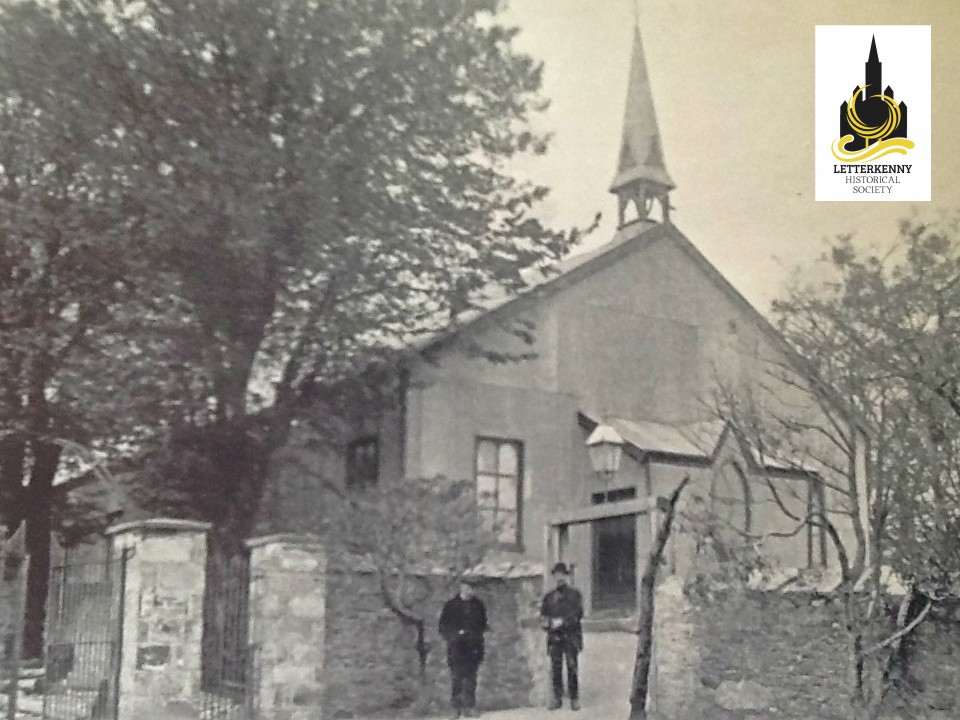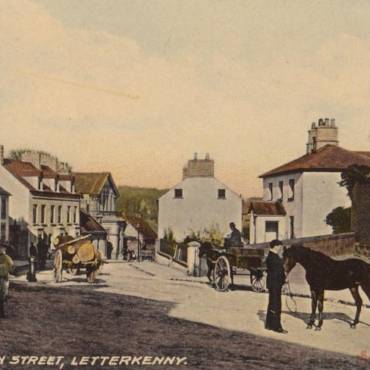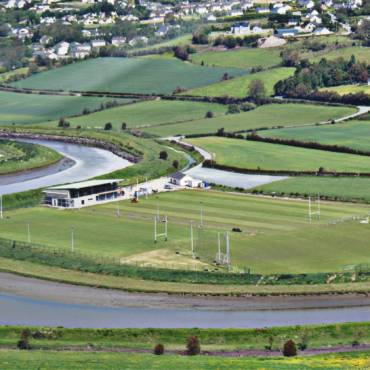The Mass Rock & Early Churches
The Penal Laws of the early eighteenth century had prohibited the public practice of Catholic worship in Ireland, which led to private masses taking place in secluded wooded areas throughout the country. Isolated locations were sought to hold these religious ceremonies, as observing the Catholic mass was a matter of severe danger for those in attendance, but especially for the priest. ‘Priest hunters’ were employed to seek out those who contravened these laws so their parishioners often hid them for protection.
A Mass Rock (Carraig an Aifrinn) was a large slab of rock used as an altar in these secluded areas for the Catholics to attend service. There were several of these in the Letterkenny area – Sam Fleming listed one in the Windyhall area while the 1836 OS Memoirs notes a “Craignasiguart” (The Priest’s Rock) in the townland of Dooballagh, near Listillion – but the one that is best known locally is located near Roger’s Burn, a small stream that divides the townlands of Sallaghgraine and Ballymacool.
Generally, the stone used for an altar would be taken from a church ruin nearby and relocated to this secluded area. Therefore the stone for the Mass Rock altar at Roger’s Burn would most likely have been taken from the old abandoned 12th Century church at Conwal. According to a report entitled “An Abstract of the State of Popery in the Diocese of Raphoe” carried out on November 4th 1731 there were two ‘Popish priests’in the parish of Conwal ‘who officiate in the open fields’ and one in the parish of Leck who ‘officiates in the open field or in some poor Cabbin’ (most likely this refers to Craignasiguart).
Six years after this, we know from a petition from the Diocese of Raphoe from 1737 that Canon Francis Mac Devitt was the Parish Priest of Conwal so he was most likely one priest who would have said mass ‘in the open fields’ at Roger’s Burn. Dominick O’Donnell is listed as Vicar of Leck so he would have been the priest who officiated at Craignasagairt. In 1704, ‘An Act for Registering the Popish Clergy’ required all priests to register their names and pay £50 to be of ‘peacable behaviour’ and from this we know that the parish priest for Conwal was a Rev. James Dougherty, aged 60, who lived in Pollans near Templedouglas while the parish priest for Conwal in 1777 was listed as Rev. James Harkin. As these years predate the building of the first Catholic Church in the town, it is most likely that these were also priests who would have officiated mass at Roger’s Burn.
Lookouts, or ‘sentries’, were usually posted on good vantage points near to the mass rocks, and would then send a series of signals to warn the mass-goers of approaching British troops (referred to as ‘Redcoats’ due to the colour of their uniform). Local sentries for Roger’s Burn were positioned on a hilltop that overlooks the Main Street and Market Square areas where the Redcoats were stationed, and thus, the locals informally christened the area ‘Sentry Hill’. A lookout would stand at various points around this area and on seeing the movement of the Redcoats, he would send a signal to other lookouts who would pass on the warning until the message was relayed successfully to the mass-goers and priest at Roger’s Burn. In 2013, a commemorative stone sculpture, designed by Redmond Herrity, was unveiled at Sentry Hill to mark this site.
The use of Mass Rocks ceased with the relaxation of the Penal Laws at the end of the eighteenth century. The first known Catholic Church in Letterkenny was built during the episcopacy of Bishop Anthony Coyle (1782 – 1801) around 1784 on a site near where St. Eunan’s College now stands. This replaced the Mass Rock at Roger’s Burn as the principal place of worship for the Catholic population of Letterkenny until a new church was erected nearer the town in 1820 on the site of the present Cathedral.
By 1830, Bishop McGettigan built a larger church on the same site and lasted over twenty years until St. Patrick’s Cathedral (or the pro-cathedral as it was later known) was consecrated on Thursday 3rd August 1854.
By 1865 though, it was decided that a much larger Cathedral was needed for the ever-growing town. Following Bishop McGettigan’s death in 1861, it was his successor, Bishop Daniel McGettigan, who started the process by raising £500 but the scheme had to be abandoned due to the depressed economic conditions prevalent in the county at the time.
No real progress occurred during Bishop MacDevitt’s occupancy of the bishopric (1871-1879) but under Bishop Michael Logue (1879-1888) the project was resurrected with large sums of money bequeathed to the building of a Cathedral by Neil Gillen (£11,000) and J.D. McGarvey (£10,000) but again, the project fizzled out due to economic hardship. When Bishop Logue became Cardinal in Armagh, the seat of the Bishopric of Raphoe became vacant and the 32-year-old Fr. Patrick O’Donnell became the youngest Catholic bishop in the world at the time.
In 1890, the Cathedral Building Committee was formed and despite the bleak economic conditions at the time in Donegal, Bishop O’Donnell called on generous people, especially of Irish descent, all over the world to help with the fund. Archbishop Logue laid the foundation stone for the new Cathedral in 1891 and over 10 years St. Eunan’s Cathedral rose up to dominate the skyline of the town with the rubble from the previous Pro-Cathedral being used in the foundations – a cathedral built on a cathedral.
While the new cathedral was being built, a small (100ft x 40ft) wooden temporary church was used for worship, the altar from which is still held in the sacristy of the cathedral. This building was built at a right angle to the cathedral site facing towards the Market Square and was located approximately where the statue of Bishop O’Donnell is today.
After 10 long years of construction, the Cathedral of Saints Eunan and Columba was formally opened in June 1901 and, along with the Church of the Irish Martyrs opened in 1994, still serves as the principal place of worship for the Catholics of Letterkenny.



